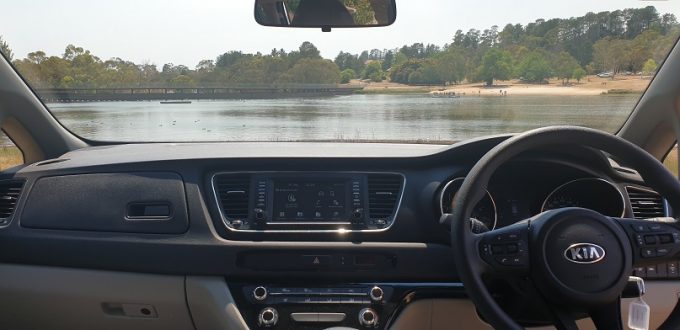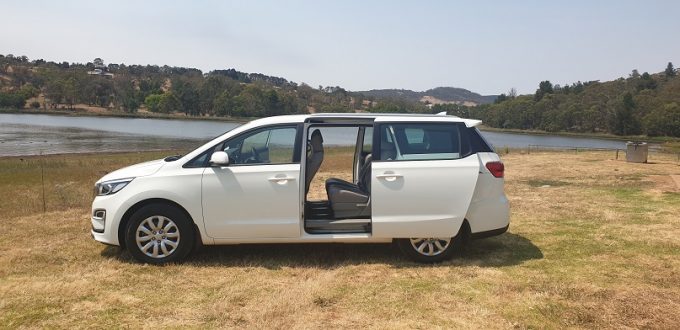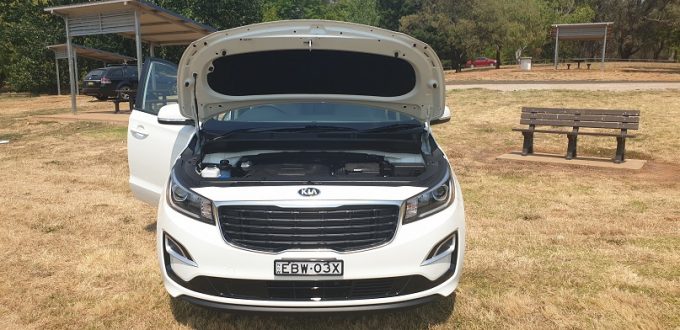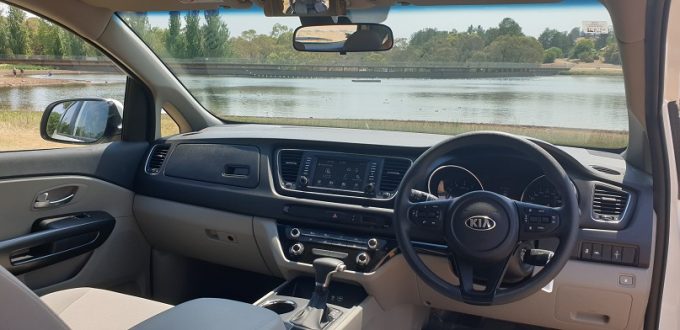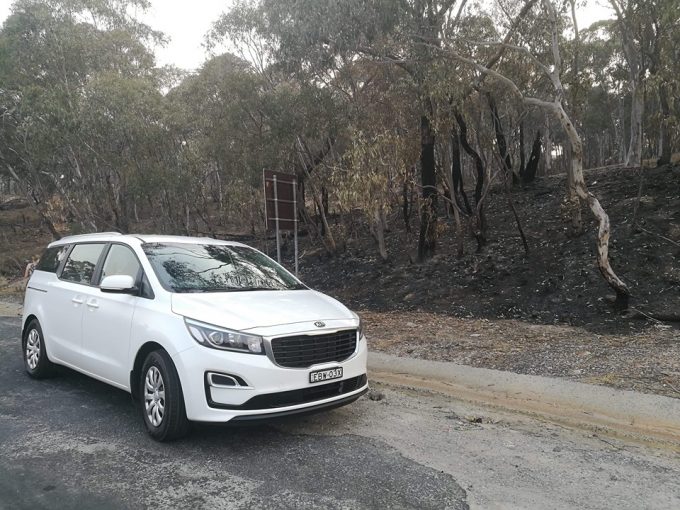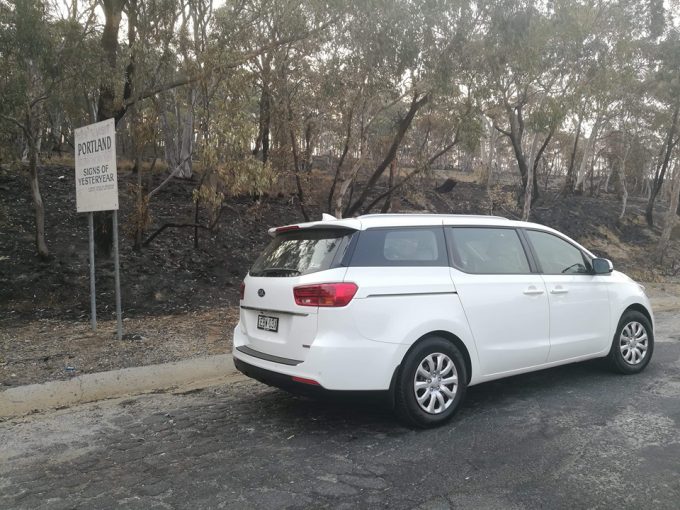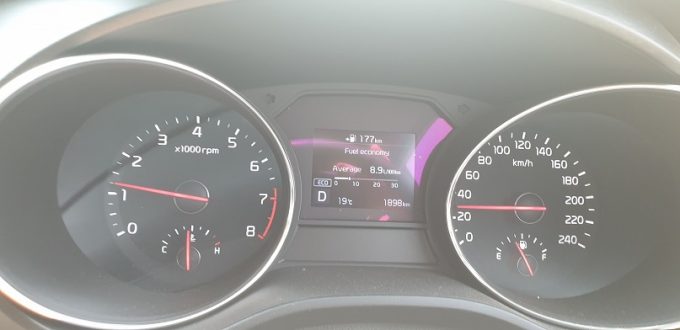The minivan may not be in vogue like the alleged “sport utility vehicle” (SUV) is, but in terms of sales, the 2020 Kia Carnival S continues to defy that trend. Throughout 2019, the Kia Carnival maintained steady year-on-year sales numbers despite the overall shrinking market.
Kia’s humble eight-seater has been the minivan of choice for quite some time now, since Toyota effectively gave up on the Tarago. We borrowed the $42,490 (before on-road costs) Carnival S V6 petrol for a family holiday to test its versatility and user-friendliness. Against the bleak, bushfire-stricken backdrop of the NSW Blue Mountains, the Carnival would have to keep its occupants well insulated from acrid, smoke-filled skies and tough weather conditions. Let’s see how it acquitted itself then.
2020 Kia Carnival S Review: Cabin space and comfort
With square lines and slab-sided packaging, the Carnival maximises its 5115mm of length, 1985mm of width and 1755mm of height better than an SUV could. An advantage of this layout is that there is room for adults in all three rows of seats and more comfort over longer journeys.
At the front, the driver enjoys somewhat of a commanding driving position and excellent visibility. The addition of a reversing camera with dynamic guidelines means that parking is never a stressful affair, but it’s worth noting the Platinum model comes with a 360-degree birds-eye camera too. The cloth trim is comfortable and almost velour-like, but doesn’t retain heat on hot days.
As you would expect, storage is exceptional, with two glove compartments and capacious door storage bins, to name a few examples. Rear climate control vents are well-positioned to ensure airflow reaches all occupants.
Boot space varies from a prodigious 960 litres to a whopping 4022L when the back two rows are folded. Its boxy form factor and under-floor mounted spare wheel no doubt go a long way here.
2020 Kia Carnival S Review: Infotainment and Ergonomics
With a standard touchscreen incorporating Apple CarPlay and Android Auto, even the base Carnival has music streaming, maps and smartphone mirroring capability. A six-speaker stereo doesn’t sound cutting-edge on paper, but produces surprisingly good bass and sound clarity. Obviously higher-level variants such as the Platinum will offer superior sound quality though, as well as integrated satellite navigation.
2020 Kia Carnival S Review: Design
While you couldn’t accuse the Carnival of being seductive, its functional design features visual elements which tie it to other models in Kia’s range. The two-box silhouette means it doesn’t fit into the “amorphous blob” category of some other MPVs historically.
Inside, the two-tone colour scheme is warm and inviting, giving a more upmarket feel than you might expect from an entry level specification. Everything is within reach, with very intuitive steering wheel controls, nice-feeling scroll wheels and volume, tone and climate knobs exactly where you’d expect.
While you wouldn’t call it luxurious thanks to the absence of leather and liberal use of hard plastics, it is a very pleasant place to spend extended periods of time.
2020 Kia Carnival S Review: Engine and Performance
The most affordable Carnival comes standard with a 3.3-litre V6, generating 206kW at 6000rpm and 336Nm at a heady 5200 revs. For an additional $2500, a turbo-diesel engine is available – a 2.2-litre unit making 147kW and 440Nm.
As our test vehicle was equipped with the petrol V6, we will focus on that engine. 206kW is an impressive number and the rev-happy V6 engine makes a pleasant sound when hustled. A mid-eight second 0-100km/h time is no mean feat for a 2094kg vehicle.
Considering the high rpm at which peak torque is achieved, we suspect the turbo-diesel might be better suited to a vehicle of this type, even if you sacrifice the nice engine note and a smidgeon of smoothness in the process. Don’t get us wrong though, the engine feels strong but we would welcome a tad more low-down torque.
2020 Kia Carnival S Review: Transmission
Equipped with a standard six-speed automatic gearbox, the Carnival never hunted or felt like it was in the wrong gear. It was able to make the most of the car’s peaky torque delivery, keeping the engine on song at all times. It is also equipped with a sequential sport shifter function, allowing you to shift on demand.
2020 Kia Carnival S Review: Handling and Steering
Whilst the Carnival is a heavy car, with a 2094kg kerb mass – its heft is well-disguised. Body control is impressive, with no pitching or yawing, but a softer suspension calibration means this is not a car with sporting pretensions. Despite this, turn-in is decently sharp and it changes direction with reasonable agility, if you remember its weight and centre-of-gravity. It possesses markedly better road manners than some commercial-based rivals, such as the Hyundai iMax.
Steering is decently-weighted but somewhat inert. Its quick ratio helps you place the car well on the road, however, and it feels very sure-footed at freeway speeds. A turning circle of 11.7 metres is reasonable for a vehicle of this size.
2020 Kia Carnival S Review: Ride and NVH
With a ride that is optimised by local engineers, the Carnival was cossetting and comfortable, thanks to long suspension travel. Noise suppression is decent, as long as you’re not expecting Mercedes-Benz levels here. There could be no greater testament to this than the uninterrupted slumber of our youngest family occupants.
2020 Kia Carnival S Review: Fuel consumption and running costs
Despite the fact the engine reaches peak torque at a relatively high 5200rpm, the Carnival really impressed us with an average 8.9L/100km on a trip that involved highways and the ascent of the Blue Mountains. Considering the official figure is 10.8L/100km, we were suitably impressed by this. Carnival’s 80-litre tank is happy with regular 91RON unleaded fuel too.
We suspect that city driving might negatively impact fuel consumption, but the turbo-diesel’s official rating of 7.6L/100km is always an option if your commute is heavy with stop-start traffic.
2020 Kia Carnival S Review: Safety
Carnival’s five star ANCAP rating is par-for-the-course in Australia’s 2020 new car market, putting it on equal footing with some of the country’s safest SUVs. You can read a full report on Carnival’s crash safety credentials here.
Forward collision alert, autonomous emergency braking, lane departure warning and stability control are just a handful of the Carnival S active safety package. Higher-up models also have rear cross-traffic alert and blind-spot detection.
One thing we liked was the supplementary convex mirror, which came in handy for supervising rear seat occupants.
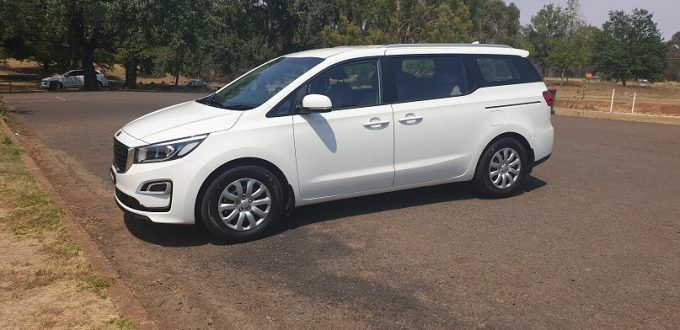
2020 Kia Carnival S Review: Value for Money
For just over forty grand, to get a strong, yet fuel-efficient engine, seating capacity for eight adults, a high level of standard equipment and good cabin presentation definitely represents good value-for-money in our opinion. The diesel option is reasonably priced and even the higher-grades dysvk up well for their extra price tags.
Capped-price servicing is at 15,000km intervals, with prices varying from $371 to $710 for more comprehensive visits. The petrol and diesel versions are more-or-less line-ball in terms of servicing costs.
Kia’s value-for-money equation has always been strong, which is one of the reasons why the brand grew last year despite the downward trend of Australia’s new car market. Its seven-year warranty and roadside assistance package is immensely compelling as well.
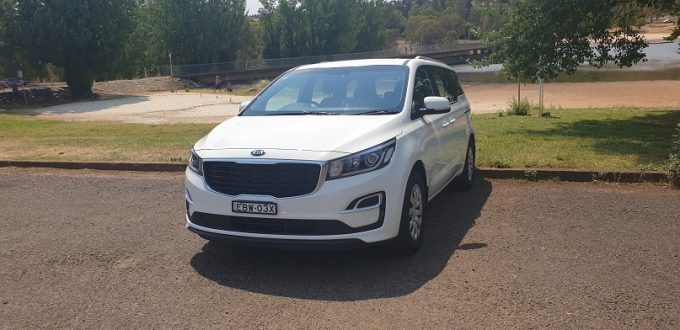
2020 Kia Carnival S Review: Conclusion
The Carnival endured a fully-loaded cabin, luggage area, a long trip with elevation changes and grim weather conditions and passed with flying colours. The 2020 Carnival is a likeable and trusty car which is enjoyable to drive and cedes little to SUVs in real-world use. If you’re torn between an SUV and an MPV, then the dilemma is primarily an image one, rather than real-world practicality.


